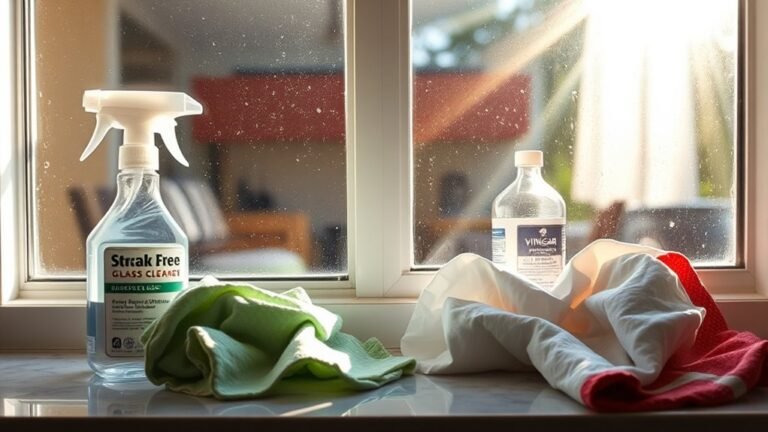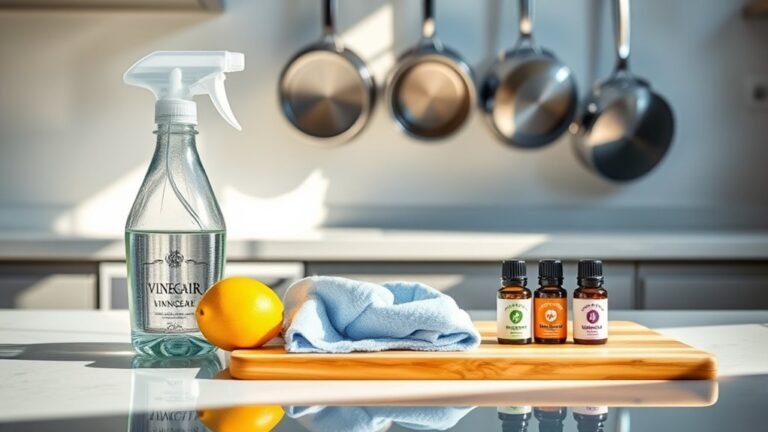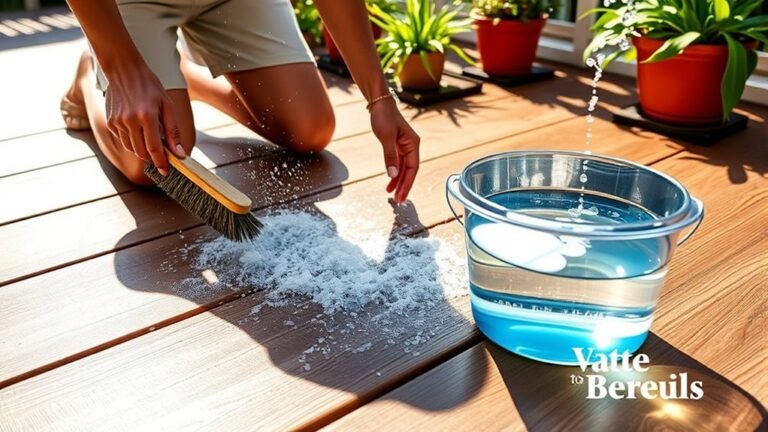How to Clean Your Home After Laminate
After installing laminate, start by sweeping or vacuuming all dust and debris thoroughly, especially in corners. Use a soft cloth with isopropyl alcohol to gently remove any adhesive residue, testing first in a hidden spot. Clean with a microfiber mop using a mild cleaner or diluted vinegar solution, avoiding excess water. Prevent scratches by choosing soft cleaning tools and wiping spills promptly. Keeping these routines consistent will maintain your floors’ pristine condition—there’s plenty more to learn for lasting care and shine.
Removing Construction Debris and Dust
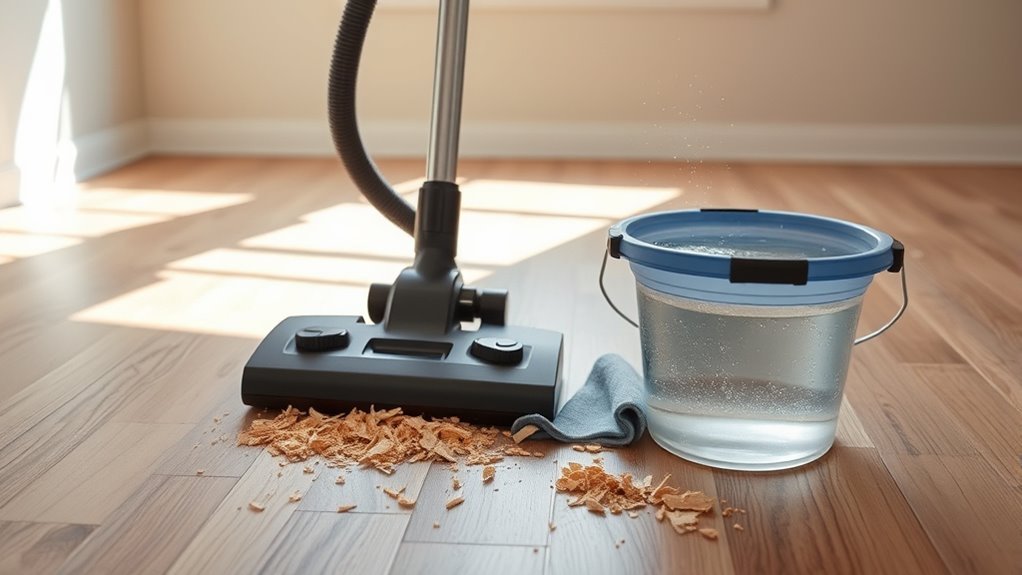
Before you begin any detailed cleaning, you’ll want to remove all construction debris and dust from your laminate floors. Start by sweeping thoroughly with a soft-bristle broom or using a vacuum equipped with a dust collection feature to capture fine particles without scratching the surface. Pay special attention to corners and edges where dust tends to accumulate. For debris disposal, gather larger fragments such as nails, wood chips, or drywall pieces using a dustpan or your hands, placing them in a designated container to prevent scattering. Avoid wet mopping at this stage to prevent dust from turning into a sticky residue. Following this methodical approach guarantees your laminate floors remain pristine and ready for the next cleaning steps, granting you the freedom to enjoy a spotless, inviting space. Using gentle cleaning methods will help preserve the laminate surface during this process.
Eliminating Adhesive Residue Safely
Once you’ve cleared away all dust and debris, the next step is tackling any adhesive residue left on your laminate floors. Start by identifying adhesive removal techniques that won’t damage the surface. Avoid harsh chemicals; instead, opt for safe solvents like isopropyl alcohol or a mild adhesive remover specifically designed for laminate. Apply the solvent sparingly to a soft cloth, not directly onto the floor, to prevent oversaturation. Gently rub the residue in a circular motion until it loosens. If needed, use a plastic scraper to lift stubborn spots without scratching. Always test solvents in an inconspicuous area first. After removal, wipe the area with a damp cloth to eliminate any solvent traces. This method guarantees effective adhesive removal while preserving your laminate’s finish and giving you the freedom to enjoy a clean, damage-free floor. Maintaining consistent indoor humidity levels is essential to protect the laminate surface during cleaning.
Choosing the Right Cleaning Tools for Laminate
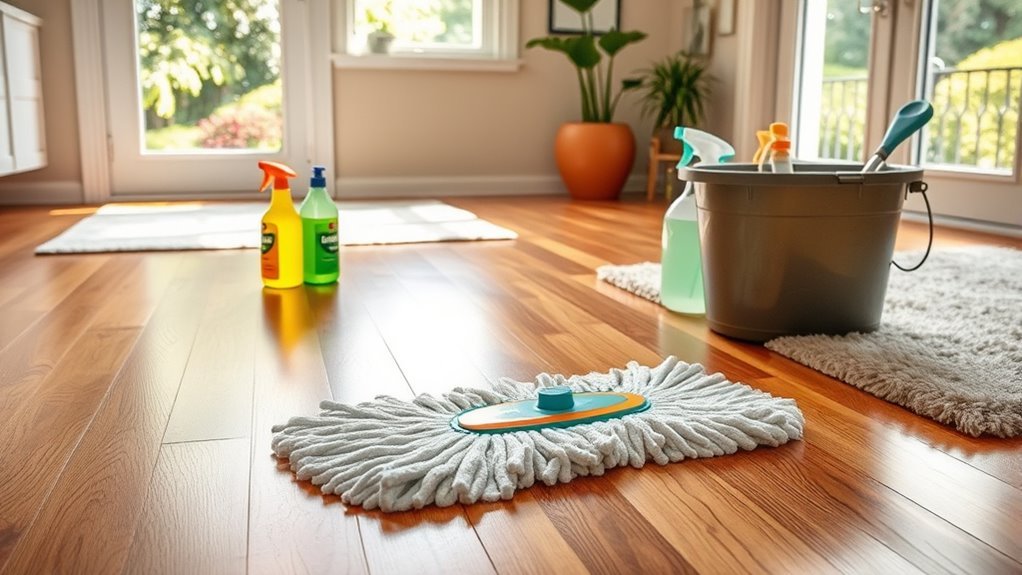
Selecting the right cleaning tools is essential for maintaining your laminate floors without causing damage. You’ll want to use appropriate tools that effectively clean without scratching or warping the surface. Start with a soft microfiber mop or cloth, as these pick up dust and dirt gently yet thoroughly. Avoid abrasive scrubbers or rough sponges that can harm the laminate finish. When vacuuming, opt for one with a hard floor setting or use a brush attachment to prevent scuffs. Verify your cleaning materials are designed for laminate floors—this includes non-abrasive dusters and mops that won’t leave residue. By choosing the right cleaning tools and materials, you preserve the floor’s appearance and enjoy the freedom of a clean, damage-free surface. A microfiber mop is essential for dust trapping without scratching, making it one of the best tools for daily laminate floor care.
Best Cleaning Solutions for Laminate Floors
With the right tools in hand, the next step is choosing cleaning solutions that keep your laminate floors spotless without causing damage. You want options that balance effectiveness with safety. Among the best commercial cleaners, look for pH-neutral products designed specifically for laminate. They clean thoroughly without stripping finishes. If you prefer homemade solutions, simple mixtures like vinegar diluted with water can work well, but use sparingly to avoid moisture damage. Here are three reliable options:
Choose pH-neutral cleaners or gentle homemade solutions like diluted vinegar to keep laminate floors spotless and safe.
- pH-neutral commercial laminate cleaners for deep, safe cleaning
- A vinegar and water mix (1 cup vinegar to 1 gallon water) for gentle, natural cleaning
- Mild dish soap diluted in water for everyday dirt and grime removal
Choosing wisely means protecting your floors while keeping your home fresh and inviting. Remember to avoid excessive water during cleaning to prevent warping or damage to your laminate floors.
Techniques for Mopping Without Damaging Laminate
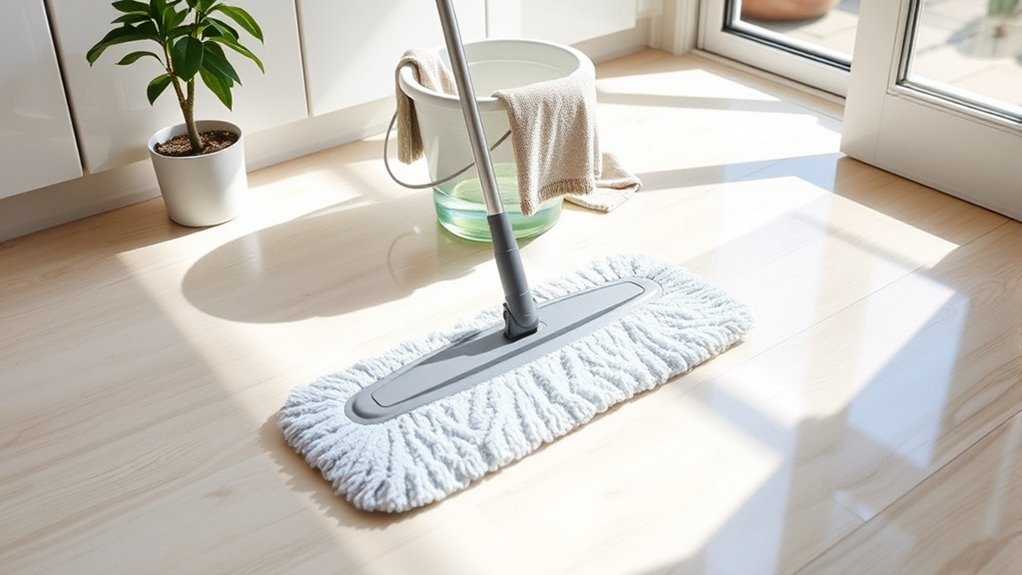
You’ll want to select a mop that’s gentle, like a microfiber or flat mop, to protect your laminate’s surface. Use mild cleaning solutions specifically designed for laminate floors to avoid damage. After mopping, make sure the floor dries quickly by wiping it with a dry cloth or using proper ventilation. Avoid using harsh chemicals like bleach, which can damage flooring finishes and cause discoloration, similar to their effects on colored grout.
Choosing the Right Mop
Although it might seem straightforward, choosing the right mop is essential to maintaining your laminate floor’s integrity. Not all mop types and mop materials suit laminate, as excess water or abrasive fibers can cause damage. To protect your floors, consider these options:
- Microfiber mops: Soft, absorbent, and gentle, ideal for trapping dust and light moisture without scratching.
- Flat mops: Easy to maneuver and control moisture, reducing the risk of water seepage between boards.
- Sponge mops with wringers: Only if you can thoroughly wring them out, preventing excess water on the surface.
Avoid string mops or abrasive materials that can leave scratches or water stains. By selecting the right mop, you’ll keep your laminate floor looking fresh and durable while enjoying the freedom to clean efficiently and safely.
Using Gentle Cleaning Solutions
Selecting the right mop sets the foundation for safe cleaning, but the solution you use matters just as much. To protect your laminate, opt for gentle cleaners made from natural ingredients or homemade cleaners. Avoid harsh chemicals or excessive water, which can cause swelling or dullness.
| Cleaning Solution | Benefits |
|---|---|
| Vinegar & Water Mix | Natural disinfectant, mild |
| Mild Dish Soap & Water | Effective, gentle on finish |
| Commercial Laminate Cleaner | Specifically formulated |
When mopping, dampen the mop slightly—never soaking wet—to prevent water damage. These gentle cleaning solutions help preserve the laminate’s appearance and durability, allowing you to maintain your floors with confidence and freedom.
Proper Drying Techniques
While mopping with a damp cloth is essential to protect your laminate, properly drying the surface immediately afterward is equally critical to prevent water damage. You want to guarantee no moisture lingers, which can cause warping or swelling. Here’s how you can master drying techniques:
- Use a clean, dry microfiber cloth or mop to absorb residual water promptly.
- Enhance humidity control by opening windows or using a dehumidifier to reduce moisture levels.
- Promote air circulation with fans or ceiling vents to speed drying and prevent damp spots.
Preventing Scratches and Maintaining Shine
To keep your laminate floors scratch-free and shiny, always use soft cleaning tools like microfiber cloths or mops. Stick to gentle cleaning solutions that won’t strip the surface or cause damage. Regularly dusting and buffing your floors will help maintain their appearance and prevent buildup.
Use Soft Cleaning Tools
Because laminate surfaces can scratch easily, you should always use soft cleaning tools like microfiber cloths or gentle sponges. These help preserve the finish and maintain the surface’s natural shine without causing damage. When selecting your cleaning tools, keep in mind:
- Use soft cloths to wipe dust and spills gently.
- Choose gentle sponges for more stubborn spots, avoiding abrasive scrubbers.
- Avoid using rough brushes or steel wool, which can leave permanent scratches.
Apply Gentle Cleaning Solutions
Although you might be tempted to use strong cleaners for tough stains, it’s important to stick to gentle cleaning solutions when caring for laminate surfaces. Harsh chemicals can dull the finish and cause scratches over time. Instead, opt for eco friendly options like diluted vinegar or mild dish soap mixed with water. These homemade mixtures effectively clean without damaging your floors. Apply the solution sparingly with a soft cloth or mop, avoiding excess moisture that could seep into seams. Always test your mixture on a small, hidden area first to verify compatibility. By using gentle, natural cleaners, you maintain your laminate’s shine and prevent surface wear, giving you the freedom to enjoy a spotless, healthy home without compromising your flooring’s integrity.
Regularly Dust and Buff
Gentle cleaning solutions help preserve your laminate’s finish, but dust and debris can still accumulate daily, risking scratches and dullness if left unattended. To maintain your floor’s shine and prevent damage, you should adopt effective dusting techniques and buffing methods. Here’s how to stay on top of it:
- Use a microfiber dust mop or cloth to gently trap dust without scratching the surface.
- Avoid harsh sweeping tools that can grind debris and cause micro-scratches.
- After dusting, apply a soft, dry cloth in circular motions to buff the laminate, restoring its natural luster.
Routine Maintenance Tips to Keep Laminate Floors Pristine
When you want to keep your laminate floors looking their best, consistent routine maintenance is essential. Start with routine cleaning by sweeping or vacuuming daily to remove dust and debris that can scratch the surface. Use a microfiber mop dampened with a laminate floor cleaner or a mixture of water and vinegar to gently clean the floor without causing damage. Avoid excess water, as it can seep into seams and cause swelling. For floor maintenance, place protective pads under furniture legs to prevent dents and scratches. Address spills immediately by wiping them up with a dry cloth to avoid staining. Finally, maintain proper humidity levels in your home to prevent the laminate from warping. Following these steps gives you freedom from frequent deep cleaning while keeping floors pristine. Using a DIY laminate cleaner ensures gentle cleaning without harsh chemicals, preserving the floor’s finish and health.
Frequently Asked Questions
Can Laminate Flooring Be Cleaned With Steam Mops?
You might wonder about steam mop effectiveness on laminate floors. While steam mops can clean thoroughly, they pose risks to laminate floor safety because excessive moisture and heat can cause warping or damage the protective layer. To keep your floors safe, it’s best to avoid steam mops or use them cautiously with low settings and minimal water. Opt for damp mopping instead for effective cleaning without compromising your laminate’s integrity.
How Soon After Installation Can I Clean Laminate Floors?
You should wait at least 48 hours after installation before cleaning your laminate floors to allow the adhesive and seams to set properly. After this installation timing, cleaning frequency depends on your lifestyle—usually, a light sweep or vacuum a few times a week and a damp mop once a week works well. Avoid excessive water to keep your floors looking great, giving you the freedom to enjoy a clean, durable surface without worry.
Are There Any Natural or DIY Cleaners Safe for Laminate?
Imagine Sarah, who wanted to avoid harsh chemicals on her new floors. She chose homemade solutions, like a vinegar mixture—one cup vinegar to a gallon of warm water—for safe, natural cleaning. You can use this method too, just be sure to wring your mop thoroughly; excess water can damage laminate. This DIY approach keeps your floors spotless while giving you freedom from synthetic cleaners, making maintenance both effective and eco-friendly.
Can Pet Stains Damage Laminate Flooring Permanently?
Yes, pet stains can damage laminate flooring permanently if not treated quickly. The moisture and acids can seep into the seams, causing swelling or discoloration. To prevent lingering pet odor and guarantee effective stain removal, act fast by blotting the area, using a gentle cleaner safe for laminate, and drying thoroughly. Regular maintenance helps keep your floors looking fresh and free from damage caused by pet accidents.
How to Handle Water Spills on Laminate Floors?
Imagine your laminate floor as a book—water spills are like sudden coffee stains, threatening to blur the pages forever. When you spot a water spill, act fast: blot it up with a dry cloth to prevent water damage. Avoid soaking the floor, as laminate isn’t waterproof. For spill prevention, use mats and promptly clean messes. This careful approach keeps your floors looking fresh, letting you enjoy the freedom of a worry-free home.


